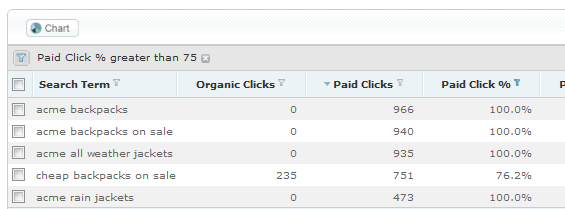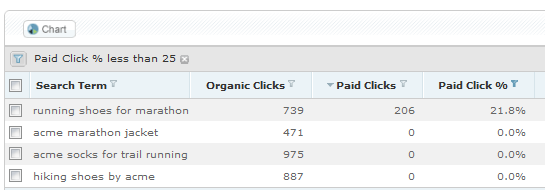The One Metric You Need To Optimize Across Paid & Organic Search
The importance of a combining SEO and SEM to optimize online performance is not a new idea. Paid advertising programs cannot be successful without top ranking natural search results and vice versa. That is why most large scale organizations typically have experts focused on each practice separately. Every once and a while, it’s important to […]
The importance of a combining SEO and SEM to optimize online performance is not a new idea. Paid advertising programs cannot be successful without top ranking natural search results and vice versa. That is why most large scale organizations typically have experts focused on each practice separately. Every once and a while, it’s important to combine forces, and make sure that your online advertising program is optimized across paid and organic search.
When SEO and SEM teams are operating independently, there are often high volume terms that drive traffic from only one of the two search channels. These terms are often under-optimized. For example, if you have a term for which traffic is only driven through paid search clicks, there is significant opportunity to focus SEO efforts on obtaining organic ranking on these terms.
Conversely, if your organization is generating revenue from organic search terms that don’t match any of the keywords in your paid search program, there is likely incremental revenue that you can capture with paid keyword expansion.
So, occasionally paid and organic search teams need to work together, but what’s the best way for a large scale organization to address this analysis? It would be impossible to compare organic and paid search coverage on every one of the millions of search terms that are driving traffic to your site.
How To Look At Large Data Sets For Opportunities
As with all analysis we do on large data sets, it is important to take a management by exception approach. Start with the high-volume and top converting search queries in each channel. Once you have filtered to find the most impactful search queries, the next step is to evaluate how they perform.
Instead of comparing the number of impressions, clicks and conversions that each channel is driving, the easiest way to evaluate coverage is to calculate the click-share of each channel. Depending on the type of tracking system you are using there are a variety of ways to get this metric, but to keep it generic: match raw query search terms across paid and organic results, sum the total clicks, and calculate the paid clicks as a percentage of that total.
This single metric, “Paid Click Percentage”, makes it easy for an advertiser to quickly identify holes in either paid or organic search coverage. Again, using the management-by-exception approach, you want to identify outliers first when tackling this analysis. Below is an example report.
In the screenshot above, by filtering for paid click percentage greater than 75%, we have quickly identified some key revenue driving terms for our paid search program that are receiving very few (or zero) clicks from organic search results.
Because searchers are more inclined to click on organic results instead of ads, we know that a term with zero organic clicks must not be resulting in first page organic results. Sorting these terms by paid search revenue impact will give the organic search team a ranked list of queries (and landing pages) to optimize against, allowing them to be more efficient at prioritizing SEO projects.
After you address prioritization of organic search efforts, you can use this same report to identify keywords that should be added or refined in your paid search campaigns. See the screenshot of a sample set of search terms below.
It is important to investigate the list of terms that are getting a small percentage of traffic from paid search to figure out what is causing the holes. In the case above, the paid search campaign might be missing the keyword “acme marathon jacket,” the keyword bid might be below the minimum first page bid, or the keyword may have a low quality score.
A quick search for this term across your paid search campaign will help you understand if you simply need to add a new term, or if you need to adjust creative or bids in order to reach the first page of results.
Refine, Review, Repeat
As I mentioned in the beginning, a comprehensive approach to online advertising in which paid and organic channels work together will help you drive maximum revenues from your program. Identifying holes in paid and organic search campaigns using the method described above should help improve overall performance, but remember: it’s not a one-time project.
Since websites and advertising programs are continually changing, this analysis should be done on a regular basis. If your organization is large enough to have disparate paid and organic search teams, set up a regular meeting to ensure your online initiatives are working together. This approach should deliver a more complete and efficient marketing program.
Contributing authors are invited to create content for Search Engine Land and are chosen for their expertise and contribution to the search community. Our contributors work under the oversight of the editorial staff and contributions are checked for quality and relevance to our readers. The opinions they express are their own.
Related stories
New on Search Engine Land

